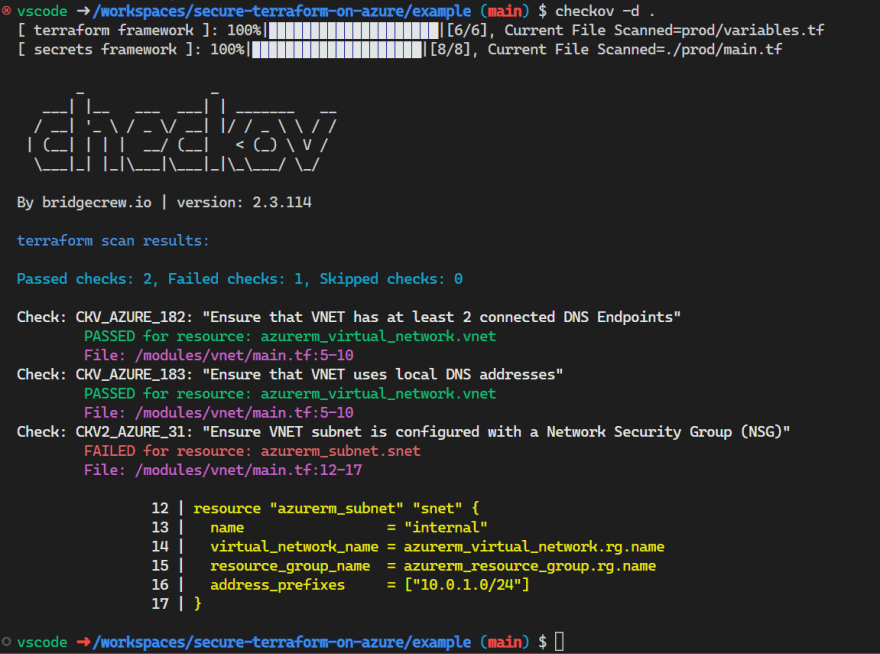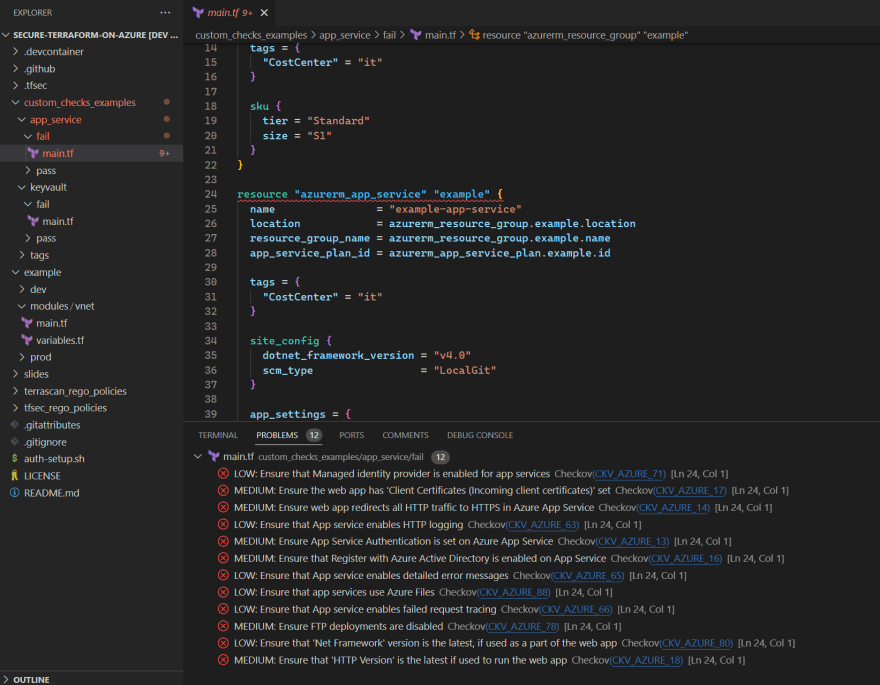Secure Terraform - Part 4 - checkov

Chris Ayers
Posted on March 27, 2023
Secure Terraform - Part 4 - Checkov
In this fourth installment of our Secure Terraform series, we’ll discuss Checkov, a powerful open-source static code analysis tool supported by Bridgecrew. Checkov supports Terraform, Kubernetes, Dockerfiles, AWS CloudFormation, and other Infrastructure as Code (IaC) frameworks. It focuses on security best practices, policy compliance, and industry standards. You can find Checkov’s documentation and samples at https://www.checkov.io/.
Checkov Installation and CLI
Checkov can be easily installed using pip, a package installer for Python:
pip install checkov
Alternatively, you can install Checkov using Docker:
docker pull bridgecrew/checkov
Once installed, Checkov provides a command-line interface (CLI) to scan your IaC files. To scan your Terraform code, navigate to your project’s root directory and run the following command:
checkov -d .
Checkov will then analyze your Terraform files, checking for security and compliance issues. It will output the results, including the test status (PASSED or FAILED), file paths, resource types, and relevant information about the issue.
You can customize the output format using the –output flag. Checkov supports various output formats, including JSON, JUnit XML, and SARIF:
checkov -d . --output json
Checkov extensions for VS Code
Checkov provides extensions for VS Code and other IDEs, allowing you to scan your Terraform code directly from your code editor. This is a convenient way to scan your code as you write it, ensuring that you don’t introduce any security or compliance issues.
To install the Checkov extension for VS Code, search for “Checkov” in the Extensions tab or install it from the marketplace.
You can scan your code and view the results in the Checkov Output tab. You can also view the results in the Problems tab, which provides a convenient way to navigate to the specific line of code that caused the issue.
And if you hold your cursor over the issue, you can see the violations and links to the related checks.
If you click on the check, you’ll get a pop-up and follow the link to the Checkov documentation.
This is an amazing developer experience, allowing you to scan your code as you write it and fix any issues immediately.
Checkov in CI/CD Pipelines
Integrating Checkov into your CI/CD pipeline helps ensure that your infrastructure is secure and compliant with every code change. Here’s an example of how to integrate Checkov into a GitHub Actions pipeline:
name: Checkov
on:
push:
branches:
- main
jobs:
build:
runs-on: ubuntu-latest
steps:
- uses: actions/checkout@v2
- name: Set up Python 3.8
uses: actions/setup-python@v1
with:
python-version: 3.8
- name: Test with Checkov
id: checkov
uses: bridgecrewio/checkov-action@master
with:
directory: example/examplea
framework: terraform
This example workflow triggers on push and pull_request events for the main branch. It checks out the repository, sets up Python, installs Checkov, and runs a scan on the specified Terraform files.
Custom Policies and Suppressions
Checkov supports custom policies written in Python or Yaml. You can create a custom policy by following these steps:
- Create a new directory for your custom policies, e.g., custom_policies.
- Inside the custom_policies directory, create a new Python or Yaml file for your custom rule, e.g., my_custom_rule.py or my_custom_rule.yaml.
- Write your custom rule using Python or the Yaml language. Refer to the Checkov documentation for guidance on writing custom policies.
In addition to custom policies, Checkov allows you to suppress specific checks or resources using inline comments in your Terraform code.
This can be useful when you want to exclude certain resources from specific checks. To suppress a check, add the following comment above the resource block:
# checkov:skip=CKV_AZURE_123:This check is not applicable for this resource
resource "azurerm_storage_account" "example" {
# ...
}
In this example, the CKV_AZURE_123 check will be skipped for the azurerm_storage_account resource with a reason “This check is not applicable for this resource.”
Conclusion
Checkov serves as a robust tool to bolster the security and compliance of your Terraform code. By seamlessly integrating Checkov into your development workflow, CI/CD pipeline, and leveraging it with your code editor, you can proactively tackle potential security risks and policy violations during the development stage itself.
The adaptability of Checkov, with its support for custom policies and the ability to selectively suppress checks, empowers organizations to customize the tool to align with their specific security objectives.
Utilizing tools like Checkov, along with others like tfsec and Terrascan, plays a pivotal role in creating and sustaining a secure and compliant infrastructure in today’s rapidly evolving landscape, where Infrastructure as Code has become a fundamental component of modern development practices.

Posted on March 27, 2023
Join Our Newsletter. No Spam, Only the good stuff.
Sign up to receive the latest update from our blog.





